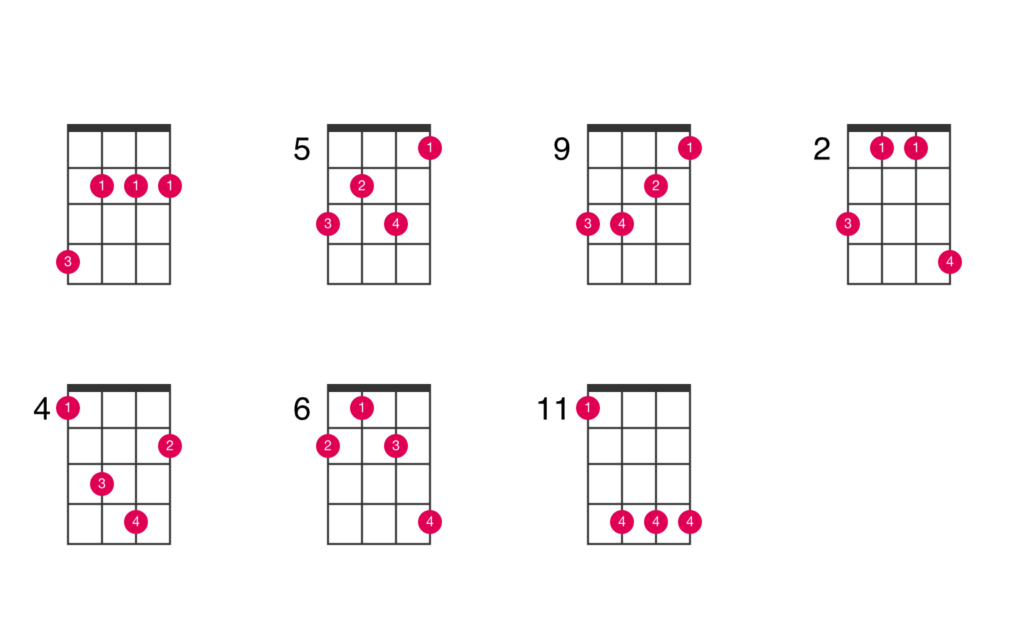Mastering B Minor Ukulele And How To Play
Dive into the lush soundscape of the ukulele by conquering the elusive B minor ukulele chord. B minor symbolized as Bm, adds a touch of melancholy and depth to your musical palette. In this guide, we'll unravel the mysteries of mastering the Bm chord on your ukulele. It's a chord that might seem simple at first glance but holds immense potential to elevate your playing.
B minor ukulele chord explanation
The B minor chord (Bm) is formed by taking the 1st, 3rd, and 5th notes from the B major scale (B, C#, D#, E, F#, G#, A#). In the B major scale, the 1st, 3rd, and 5th notes are B, D#, and F#.
To convert this into a minor chord, we lower the 3rd note (D#) by a half step to D, resulting in the notes B, D, and F# for the B minor chord (Bm). This gives the B minor chord its characteristic minor tonality, which is a sad or melancholic sound compared to the major chord.
The B minor guitar chord holds significant power and is a fundamental element in diverse music genres like blues, jazz, and rock. By blending elements of both darkness and light, the Bm chord infuses music with emotion and tension. Thus, accounting for its widespread popularity across musical styles. Ultimately, the Bm chord stands as evidence of how simplicity and strength harmoniously combine, making it attractive to musicians with various tastes and experiences.

How to play B minor ukulele
Way to play Bm chord ukulele
Let's explore how to play the B minor ukulele, breaking down each finger's position and the corresponding fret on the fretboard. Utilizing ukulele chord charts is an excellent visual aid in understanding the finger placements on the four strings of your ukulele:
- G = The fourth string
- C = The third string (the lowest tone)
- E = The second string
- A = The first string (the highest-tone string)
In contrast to the guitar, where strings are ordered in a descending manner, the lowest-toned string on a ukulele is actually the third string. Within these charts, you'll find numbers and symbols guiding you on where to position each finger to play the B minor chord correctly.
Here's a breakdown of finger positions for the B minor chord:
- Index finger: 2nd fret of the C, E, and A strings
- Ring finger: 4th fret of the G string

Some Bm ukulele chords

Comparison B minor uke with guitar
The Bm chord on the ukulele and guitar shares the same fundamental structure and tones (B, D, F#). However, the position and playing technique differ due to the variations in the instruments' structures and string numbers.
In both cases, the Bm chord consists of three notes: B (root), D (minor third), and F# (perfect fifth). However, the way of playing and finger placement on the strings differs because the guitar and ukulele have distinct string structures and playing styles.
You have multiple options to play the Bm guitar chord, including various open chord and barre chord variations at different positions on the fretboard. On the ukulele, with fewer strings and a different instrument structure, Bm chord patterns are simpler, focusing on the 4 strings (G, C, E, A) of the ukulele.
In summary, despite both having the same basic note structure, how you play Bm on the ukulele and guitar will differ due to the variations in instrument structure and the number of strings each type of instrument has.
As you continue your musical journey, practice and incorporate the B Minor ukulele chord into your repertoire. You'll find a new dimension to your ukulele playing. The depth it adds, the feelings it conveys, and the stories it tells make it an indispensable chord for any player.






